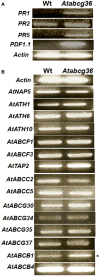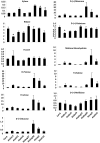Influence of ATP-Binding Cassette Transporters in Root Exudation of Phytoalexins, Signals, and in Disease Resistance
- PMID: 22783269
- PMCID: PMC3389762
- DOI: 10.3389/fpls.2012.00149
Influence of ATP-Binding Cassette Transporters in Root Exudation of Phytoalexins, Signals, and in Disease Resistance
Retraction in
-
Retraction: Influence of ATP-binding cassette transporters in root exudation of phytoalexins, signals, and in disease resistance.Front Plant Sci. 2013 Oct 23;4:424. doi: 10.3389/fpls.2013.00424. eCollection 2013. Front Plant Sci. 2013. PMID: 24167511 Free PMC article. No abstract available.
Abstract
The roots of plants secrete compounds as a way to exchange information with organisms living in the soil. Here, we report the involvement of seven root-expressed ATP-binding cassette (ABC) transporters corresponding to both full and half-size molecules (Atabcg36, Atabcg37, Atabcc5, Atabcf1, Atabcf3, Atnap5, and Atath10) in root exudation processes using Arabidopsis thaliana. Root exuded phytochemicals were analyzed by high-performance liquid chromatography-mass spectrometry (HPLC-MS) and gas chromatography-mass spectrometry (GC-MS), and it was determined that some of the root exudates from the corresponding ABC transporter mutants were significantly different compared to the wild type. For example, Atabcg37 and Atabcc5 secreted higher levels of the phytoalexin camalexin, and Atabcg36 secreted higher levels of organic acids, specifically salicylic acid (SA). Furthermore, we analyzed the root tissue metabolites of these seven ABC transporter mutants and found that the levels of SA, quercetin, and kaempferol glucosides were higher in Atabcg36, which was correlated with higher expression levels of defense genes in the root tissues compared with the wild type. We did not observe significant changes in the root exudates of the half-size transporters except for Atabcf1 that showed lower levels of few organic acids. In summary, full-size transporters are involved in root secretion of phytochemicals.
Keywords: ABC transporters; defense proteins; disease resistance; phytoalexin; root exudates; salicylic acid.
Conflict of interest statement
The authors declare that the research was conducted in the absence of any commercial or financial relationships that could be construed as a potential conflict of interest.
Figures










References
-
- Badri D. V., Loyola-Vargas V. M., Broeckling C. D., De-La-Pena C., Jasinski M., Santelia D., Martinoia E., Sumner L. W., Banta L. M., Stermitz F., Vivanco J. M. (2008). Altered profile of secondary metabolites in the root exudates of Arabidopsis ATP-binding cassette transporter mutants. Plant Physiol. 146, 762–771. 10.1104/pp.107.109587 - DOI - PMC - PubMed
-
- Badri D. V., Quintana N., El Kassis E. G., Kim H. K., Choi Y. H., Sugiyama A., Verpoorte R., Martinoia E., Manter D. K., Vivanco J. M. (2009). An ABC transporter mutation alters root exudation of phytochemicals that provoke an overhaul of natural soil microbiota. Plant Physiol. 151, 2006–2017. 10.1104/pp.109.147462 - DOI - PMC - PubMed
-
- Bednarek P., Pislewska-Bednarek M., Svatos A., Schneider B., Doubsky J., Mansurova M., Humphry M., Consonni C., Panstruga R., Sanchez-Vallet A., Molina A., Schulze-Lefert P. (2009). A glucosinolate metabolism pathway in living plant cells mediates broad-spectrum antifungal defense. Science 323, 101–106. 10.1126/science.1163732 - DOI - PubMed
Publication types
LinkOut - more resources
Full Text Sources
Molecular Biology Databases
Miscellaneous

